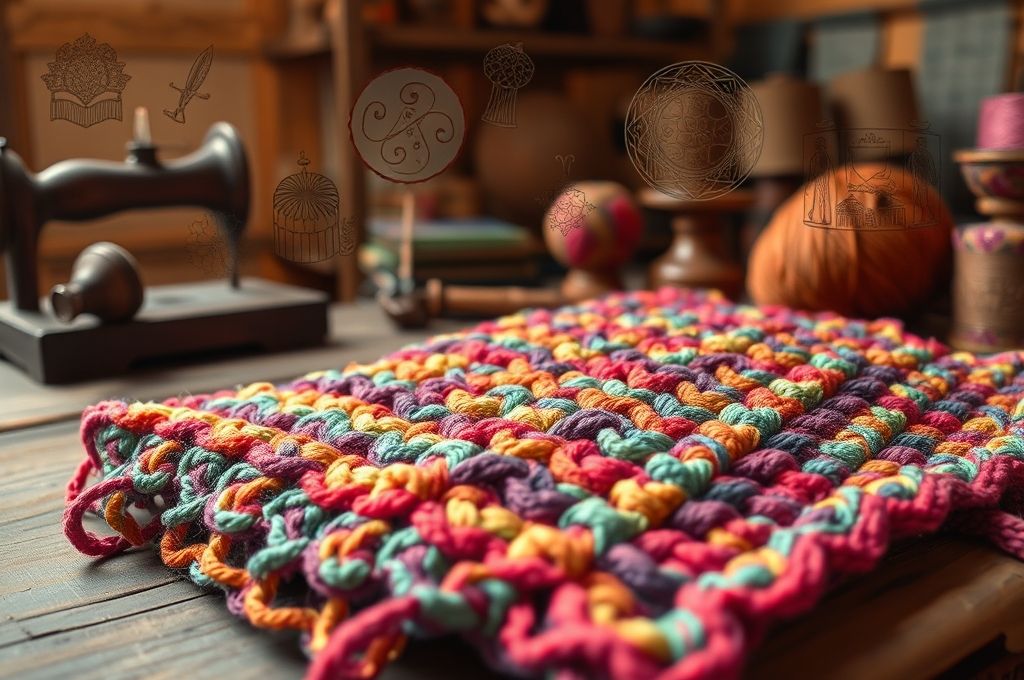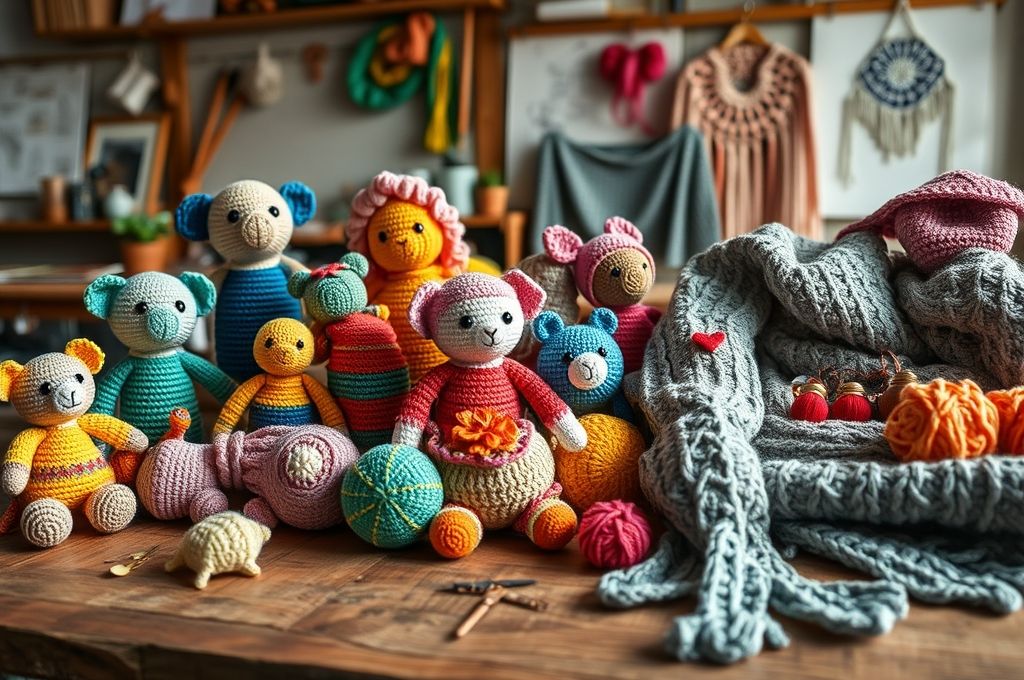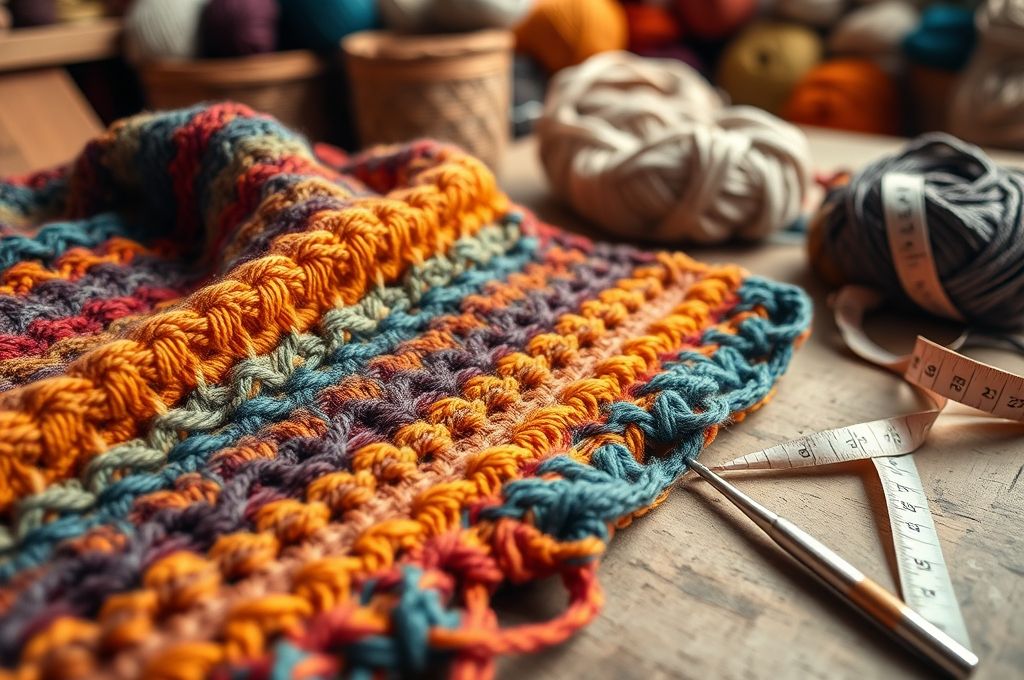Have you ever picked up a crochet hook and felt like you were weaving more than just yarn—something closer to magic? If you’re already familiar with traditional crochet, there’s a whole other world waiting for you just beyond the next stitch: Tunisian crochet. Often described as a beautiful hybrid between knitting and crocheting, Tunisian crochet creates rich, dense, and textured fabrics that drape beautifully and hold their shape with elegance. It’s the secret weapon behind cozy blankets, structured bags, and even delicate lacework.
But despite its versatility, Tunisian crochet is still underappreciated by many crafters who assume it’s too complex or time-consuming. Nothing could be further from the truth. Once you understand the rhythm of the forward and return passes, you’ll find it surprisingly meditative—almost like a dance between tension and release.
In this article, we’ll go far beyond the basic Tunisian simple stitch. You’ll discover the history that shaped this craft, explore different stitches and techniques that bring depth and movement to your work, learn practical tips to avoid common pitfalls, and see how modern makers are reinventing Tunisian crochet in bold, creative ways. Whether you’re a seasoned crocheter looking to expand your skills or a curious beginner ready to dive into something new, this journey will inspire you to pick up a longer hook and see what you can create. Let’s unravel the beauty of Tunisian crochet—one loop at a time.
What Is Tunisian Crochet, and Why Should You Care?
At first glance, Tunisian crochet might look like knitting. The fabric it produces is smooth, flat, and has a distinct vertical grain, much like stockinette stitch. But don’t be fooled—this is 100% crochet, just with a twist.
Instead of completing each stitch immediately (as in regular crochet), Tunisian crochet works in two parts: a forward pass, where you pick up loops across the row and leave them on your hook, and a return pass, where you work those loops off one by one. This creates a fabric that’s denser than traditional crochet, less stretchy than knitting, and perfect for projects where structure and warmth matter.
So why should you care? Because Tunisian crochet opens up a whole new design language. Imagine creating intricate cable patterns without needing cable needles, or making a blanket with a leather-like texture that still breathes. It’s ideal for garments, home decor, and accessories that need to hold their shape.
And here’s the best part: you don’t need a degree in fiber arts to get started. With just one special hook—a Tunisian crochet hook, which is longer than a standard hook and often has a stopper on the end—you can begin experimenting. Many beginners find the rhythm soothing, almost like counting breaths during meditation. The repetitive motion helps reduce stress, making Tunisian crochet not just a creative outlet, but a therapeutic one too.
As we dive deeper, you’ll see how this craft blends the best of both knitting and crochet worlds—and how you can use it to express your personal style in fresh, exciting ways.
A Stitch Through Time: The Surprising History of Tunisian Crochet

Believe it or not, Tunisian crochet has roots that stretch back centuries—though its name might be more misleading than enlightening. Despite being called “Tunisian,” there’s little evidence that the technique originated in Tunisia. In fact, it first appeared in European publications in the mid-19th century, particularly in England and Germany, where it was known as “shepherd’s knitting” or “tricot crochet.”
Why the name “Tunisian”? Likely due to the exoticism of the era. During the 1800s, Western Europe was fascinated by North African and Middle Eastern cultures. Naming crafts after distant lands added an air of mystery and sophistication—even if the connection was more fantasy than fact.
The technique gained popularity in Victorian times, especially among women who sought elegant, handcrafted textiles for their homes. Patterns for afghans, shawls, and cushions began appearing in women’s magazines, often using fine cotton or silk yarns to highlight the fabric’s smooth texture.
Interestingly, Tunisian crochet faded from mainstream attention in the 20th century, overshadowed by faster, more industrialized methods. But thanks to the handmade revival of the 2000s—and the rise of online communities like Ravelry and Instagram—it’s made a powerful comeback.
Today, designers are reimagining Tunisian crochet with bold colors, modern silhouettes, and innovative construction methods. From wearable art to architectural wall hangings, the technique is no longer just for grandmas’ blankets. It’s a dynamic, evolving craft that honors tradition while embracing the future.
Understanding this history isn’t just about trivia—it helps us appreciate how crafts evolve through culture, migration, and creativity. And it reminds us that every stitch we make today is part of a much larger story.
Mastering the Core Stitches: From Simple to Sophisticated
Now that you know the background, let’s get hands-on. The foundation of Tunisian crochet lies in a few core stitches. Once you master these, you can mix, match, and modify them to create endless textures.
Let’s start with the Tunisian Simple Stitch (TSS)—the gateway stitch. It’s worked by inserting your hook into the vertical bar of each stitch across the row (forward pass), then yarn over and pull up a loop, leaving all loops on the hook. On the return pass, you yarn over and pull through two loops at a time until only one remains. Simple, rhythmic, and perfect for beginners.
But don’t stop there. The Tunisian Knit Stitch (TKS) mimics the look of actual knitting. Instead of going under the vertical bar, you insert your hook from front to back, giving a smoother, more knitted appearance. Great for scarves and pullovers.
Then there’s the Tunisian Purl Stitch (TPS), which creates a bumpy, textured surface. You achieve this by wrapping the yarn around the hook before inserting it, then pulling through the vertical bar. When alternated with TSS or TKS, it produces ribbing effects—ideal for cuffs or button bands.
Want more drama? Try the Tunisian Honeycomb Stitch or Tunisian Bobble Stitch. These add dimension and visual interest, turning a plain rectangle into a piece of textile art.
Pro Tip: Use stitch markers to keep track of row beginnings, especially when working in the round or with color changes. And always remember: tension matters. Keep your forward pass consistent so your edges don’t curl.
By combining just two or three of these stitches, you can create complex-looking fabrics that impress even experienced crafters. Think of them as your alphabet—once you know the letters, you can write entire stories.
Beyond the Hook: Tools, Yarns, and Techniques That Make a Difference
You don’t need a full toolbox to start Tunisian crochet, but the right tools can elevate your experience—and your results.
First, the hook. While you can use a regular crochet hook, a dedicated Tunisian hook makes life easier. These are longer (often 10–14 inches) and come in straight, circular, or even double-ended versions. Circular Tunisian hooks are great for large projects like blankets, as they distribute the weight of all those live loops across the cable.
Yarn choice also plays a huge role. Because Tunisian fabric is denser, it uses more yarn than traditional crochet. A worsted-weight acrylic or wool blend is ideal for beginners—durable, affordable, and easy to handle. For drape, try a soft merino or bamboo blend. Avoid super-slippery silks or fuzzy mohairs until you’ve built confidence; they can make it hard to see your stitches.
One often-overlooked technique? Blocking. Tunisian pieces benefit greatly from a gentle steam or wet block, which opens up the stitches and evens out tension. It’s especially helpful for lace or openwork patterns.
And don’t forget about foundation rows. Unlike regular crochet, Tunisian doesn’t start with a chain unless you’re using a foundation chain method. Many prefer the Foundation Row Technique, where you create both the first row and the base in one go—resulting in a more elastic edge that resists curling.
Quick Checklist for Success:
- Use a hook one or two sizes larger than recommended for your yarn
- Count your stitches regularly—missing one can throw off the entire row
- Take breaks! Holding multiple loops can strain your hands
- Practice on small swatches before starting big projects
With the right setup, Tunisian crochet becomes not just manageable, but joyful.
Creative Applications: Where Art Meets Function

Now for the fun part—what can you actually make with Tunisian crochet?
Sure, blankets are a classic (and for good reason—imagine a reversible throw with a honeycomb pattern on one side and a smooth knit stitch on the other). But the real magic happens when you think outside the afghan.
Fashion-forward accessories are a growing trend. Designers are creating structured handbags, hats with architectural lines, and even shoes using Tunisian techniques. The fabric’s stability means it holds shape without lining or interfacing—perfect for minimalist, eco-conscious designs.
Wearable art is another frontier. Tunisian crochet allows for seamless construction, meaning you can work garments in one piece, minimizing seams. Picture a cardigan with built-in cables, or a vest with colorwork that looks like intarsia knitting but is actually just a clever stitch pattern.
Home decor gets a major upgrade too. Wall hangings with 3D texture, coasters with a leather-like finish, and even lampshades are being crafted using Tunisian methods. The fabric’s density makes it ideal for items that need to be both beautiful and functional.
And let’s not forget amigurumi and toys. While traditional amigurumi relies on tight single crochet, Tunisian versions offer a smoother, more sculptural look—great for creating animals with realistic fur or clothing details.
The key is to think of Tunisian crochet not as a niche technique, but as a design tool. Every stitch is a brushstroke. Every row, a line of poetry. When you shift your mindset from “making a thing” to “telling a story,” your projects gain depth and meaning.
Troubleshooting Common Challenges (And How to Avoid Them)
Even the most experienced crafters hit snags. The good news? Most Tunisian crochet problems have simple fixes.
Problem #1: Curling Edges
This is the #1 complaint. Because the forward pass pulls tighter than the return, the fabric tends to roll.
✅ Solution: Use a larger hook for the foundation row, add a border of single crochet, or block the piece. You can also alternate rows of TSS with reverse TSS to balance tension.
Problem #2: Uneven Tension
Loose first or last stitches? It’s common.
✅ Solution: Mark the first and last vertical bars. Make sure you’re not skipping the last bar or adding an extra loop at the end. Some crocheters use a slip stitch at the end of the return pass to tighten things up.
Problem #3: Dropped Loops
With 50+ loops on your hook, it’s easy to lose one.
✅ Solution: Use a hook with a stopper, or switch to a circular Tunisian hook. If you do drop a loop, don’t panic—use a smaller hook or tapestry needle to ladder it back up.
Problem #4: Fabric Too Stiff
Dense doesn’t have to mean rigid.
✅ Solution: Try a looser gauge, use a more flexible yarn, or incorporate more openwork stitches like the Tunisian Mesh Stitch.
Problem #5: Starting and Ending Rows Neatly
Gaps at the edges can ruin an otherwise perfect piece.
✅ Solution: Pull the first loop of the forward pass slightly tighter, and make sure you’re working into the correct space (usually the top two strands of the edge stitch).
Remember: every mistake is a learning opportunity. Even the pros frog (rip out) their work sometimes. What matters is that you keep going.
Innovation in the Modern Era: How Designers Are Reinventing Tunisian Crochet
Tunisian crochet isn’t stuck in the past. Today’s makers are pushing boundaries in exciting ways.
Take colorwork, for example. Unlike knitting, where stranded or intarsia techniques dominate, Tunisian colorwork relies on carrying yarn up the side or using mosaic-style patterns. Designers like Nancy Nehring and Carolynn MacAllister have pioneered methods that create intricate geometric designs with minimal ends to weave in.
Then there’s 3D Tunisian crochet—a technique that uses strategic increases, decreases, and short rows to sculpt fabric into curves and angles. Think vases, sculptural bowls, or even wearable corsets. It’s like origami in yarn.
Sustainable fashion is another area where Tunisian shines. Because the fabric is so durable, it’s perfect for zero-waste designs. Some artists are even using recycled yarns or upcycled textiles to create statement pieces that are as eco-friendly as they are beautiful.
And let’s talk about technology. With the rise of Tunisian crochet calculators, stitch generators, and digital pattern libraries, learning has never been easier. Apps can help you plan row counts, visualize stitch patterns, or convert knitting patterns into Tunisian equivalents.
Social media has also played a huge role. Instagram hashtags like #TunisianCrochet and #TunisianStitches showcase thousands of projects from around the world, creating a global community of innovators. You’re not just learning a skill—you’re joining a movement.
This isn’t your grandma’s crochet. It’s bolder, smarter, and more expressive than ever before.
From Hobby to Healing: The Emotional and Mental Benefits of Tunisian Crochet
Let’s take a moment to talk about something deeper: how this craft affects your mind and heart.
In a world that’s constantly moving—emails, notifications, endless scrolling—Tunisian crochet offers something rare: presence. The rhythmic motion of the forward and return passes creates a natural cadence, almost like a heartbeat. Many crocheters report entering a “flow state,” where time slows down and worries fade.
Studies have shown that repetitive, hands-on activities like knitting and crochet can reduce cortisol (the stress hormone), lower blood pressure, and improve focus. Tunisian crochet, with its focus on counting and consistency, is particularly effective for mindfulness.
For people dealing with anxiety, depression, or chronic pain, it can be a form of gentle therapy. One stitch at a time, you rebuild a sense of control and accomplishment. Completing a row, finishing a project—it’s all a quiet rebellion against the idea that you can’t do something.
And there’s joy in creation. There’s something deeply human about transforming a simple strand of yarn into something warm, useful, and beautiful. Whether you’re making a gift for a loved one or treating yourself to a new scarf, you’re practicing care—both for others and for yourself.
So yes, Tunisian crochet is a technical skill. But it’s also an act of self-kindness. A moment of peace. A way to say, I am here. I am creating. I am enough.
Conclusion: Your Next Stitch Awaits
We’ve traveled from the Victorian parlors where Tunisian crochet first gained popularity to the modern studios where artists are redefining what’s possible. We’ve explored stitches, tools, troubleshooting tips, and the emotional rewards of this unique craft. But more than anything, we’ve seen that Tunisian crochet isn’t just about making things—it’s about becoming something.
Every loop you pull, every row you complete, is a step toward greater patience, creativity, and resilience. You don’t need to be an expert to start. You just need curiosity, a hook, and a willingness to try.
So what’s next? Maybe it’s a small swatch in Tunisian knit stitch. Maybe it’s a bold tote bag with a cable pattern. Or maybe it’s simply sitting down for ten minutes, letting the rhythm of the stitches quiet your mind.
Whatever you choose, know this: you’re part of a living tradition. One that values slowness in a fast world. That finds beauty in repetition. That turns yarn into meaning.
Now, pick up your hook.
Your next stitch is waiting.
What’s your favorite Tunisian crochet project or stitch? Share your thoughts in the comments below—or tag us on social media with your latest creation. Let’s grow this vibrant community together.

Daniele Ferreira is passionate about the world of crochet, dedicating her time to exploring techniques, creating unique pieces, and sharing her knowledge with beginners and aficionados alike. With attention to detail and creativity, she transforms yarn into true works of art, inspiring others to discover the beauty and joy of this manual art.







